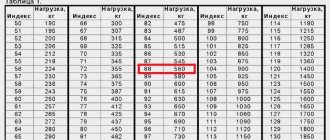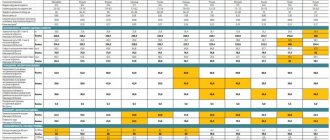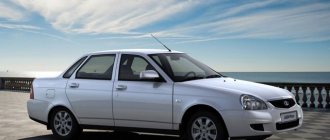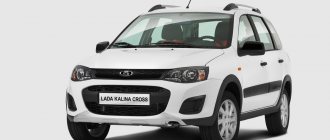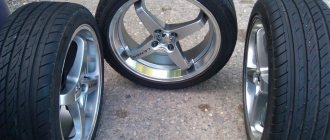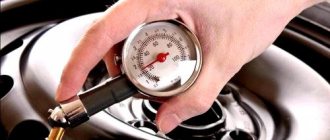The tire pressure of the Lada Largus is a very important indicator, since road grip, vehicle handling and the safety of the tires depend on it.
The fact is that tires are the only element of the car that is constantly in contact with the road surface, and accordingly takes on all the irregularities, wears out, and rubs. And all to ensure that the driver and passengers can move comfortably and safely in the car. That is why the tire pressure must strictly correspond to that set by the car manufacturer.
The tire pressure of the Lada Largus must correspond to the following established parameters - 2.4 kg/cm2 for the front wheels and 2.6 kg/cm2 for the rear wheels.
Tire pressure
For your safety, check tire pressure after the tires (including spare tires) have cooled down.
Refer to the tire pressure rating on the placard located on the end of the left front door. As you can see, it indicates the optimal tire pressure depending on the nature of the road (on and off the highway) Photo of the plate installed on the Lada Largus car
Pressure depending on modification
| Modification | Air pressure in tires, front/rear, MPa (kgf/cm2) |
| Station wagon (R90) | 0,24/0,26 (2,4/2,6) |
| Station wagon (R90) Van (F90) | 0,24/0,30 (2,4/3,0) |
| Station wagon "CROSS" package | 0,24/0,26 (2,4/2,6) |
See also the table indicating the pressure for different types of tires and modifications on the Lada Largus
The correct tire pressure must be maintained especially during overloaded or high-speed driving. When operating a vehicle with a full load and a trailer, the tire pressure should be increased by 0.2 bar. Incorrect tire pressure reduces stability, increases rolling resistance and wears out faster and even creates an accident.
If you have inflated your tires incorrectly, then: • with a twofold decrease in pressure relative to the normal value, rolling resistance doubles • and fuel consumption increases by more than 10%; • if the pressure is higher than normal, the braking distance increases, • the tires wear out, • in addition, they make more noise: they hum if the pressure is reduced, and whistle if it exceeds the correct value; • and in general, driving becomes more dangerous: tires can collapse!
Pound-force In Russia, tire pressure is usually measured in bars or atmospheres. The unit of measurement psi (pound-force per square inch, that is, pound-force per square inch) came from the USA. 1 bar is approximately equal to 1 kgf/cm2, or 0.9896 atm, or 14.5 psi. The kilopascal unit of measurement is less commonly used: 1 kPa = 0.145 psi; 1 psi = 6.895 kPa.
How to inflate tires correctly The required pressure depends on the type and size of the tire, the time of year and outside temperature, the load on the car, and the type of roads. Not everyone remembers that at negative temperatures, tire pressure drops by 0.1 bar for every -10 °C relative to 0 °C, and in hot weather it increases, sometimes up to 1 atm. High-quality modern tires can withstand such overload, but they should not be used constantly in this mode.
Normal passenger car tire pressure is in the range of 2-3 bar.
It is necessary to measure and adjust tire pressure only in a cold state, before driving. And regularly! And if you are going on a long trip, then the procedure becomes mandatory.
Detailed information about exactly how many atmospheres, bars or psi should be in your car's tires can be found in the owner's manual, on the back of the gas filler flap, in the doorway or in the spare tire well.
Checking the condition of wheels and tires
For driving safety and extending the service life of tires, it is necessary to visually check them before leaving, identifying damage (cuts, punctures), and remove foreign objects stuck in the tread blocks or between them. Cracks and abrasions on curbs may occur on the outer sidewalls of tires during unsuccessful parking. It is necessary to maintain the required pressure in the tires (including the spare wheel), regularly (at least once a month) check the pressure with a pressure gauge and bring it to normal. It is also necessary to check tire pressure when the ambient temperature drops or rises significantly and before driving long distances. Recommended tire pressure values are indicated on the plate affixed to the end of the left front door. The plate shows the air pressure in the front and rear tires when driving off and on the motorway.
Tire pressure chart. When driving a car for a long time, especially at high speeds, the tires heat up and the pressure in them increases. Therefore, the air pressure should be checked on cold tires before driving. If it is not possible to measure the pressure on cold tires, it is necessary to take into account the increase in air pressure in the tires due to heating by 0.2–0.3 bar. To check the pressure...
...unscrew the wheel valve cap...
...and connect a tire pressure gauge or a pump with a pressure gauge to the valve. If the pressure is lower than required, use a tire pump or compressor to inflate the tire, monitoring the pressure using a pressure gauge. If the pressure is higher than required, press the special protrusion of the pressure gauge (or a suitable tool) onto the spool, release air from the tire in small portions and check the pressure. When operating a vehicle with a full load and a trailer, the tire pressure should be increased by 0.2 bar. Tires should not have bulges, tread separation or damage that exposes the cord.
A worn or damaged tire should be replaced immediately, without waiting for its emergency destruction, to be replaced with a new one. It is prohibited to install tires of different models on one axle, as well as tires that do not match the size and load of the vehicle. The remaining tread height must be at least 1.6 mm.
To monitor tread wear, indicators are made in its grooves in the form of protrusions 1.6 mm high.
At the locations of the wear indicators, marks in the form of a triangle or the letters “TWI” are applied to the sidewalls of the tires. With critical wear on the tread along its entire width, the indicators form noticeable transverse stripes. You can also check tread wear using a caliper. For this…
...we lower the depth gauge into the groove in the middle part of the tread (as a rule, the tread wears out faster in this area) and make sure that the height of the tread pattern is more than 1.6 mm. To reduce the chance of error, it is advisable to take measurements at three different points around the circumference of the tire. If wear exceeds the maximum allowable limit, the tires must be replaced. The manufacturer does not recommend changing wheels
. We regularly check the tightness of the wheel bolts and tighten the bolts if necessary. If vibrations occur while driving on a flat road and in a limited speed range, you need to have the wheels balanced at a tire shop. Vibration at all speeds can be caused by patchy tire wear, bulges or other damage, or deformation of the rim. In addition, vibration can be caused by dirt deposits on the wheel rim (especially on the inside), so it is necessary to periodically wash the rims. Wheel rims should be kept clean to prevent corrosion. Areas with damaged coating can be cleaned with sandpaper, degreased, primed and painted.
When a decrease or excess of pressure is allowed
There are situations in which violating the manufacturer’s recommendations is only for the benefit of the car. We are now talking about the contact patch, which increases with decreasing pressure in the tread and vice versa (decreases with increasing). When might this come in handy?
When driving on soft ground
By reducing the pressure by about one-fourth, you will thereby increase the contact patch by almost one and a half times. Accordingly, the movement will be easier, since the pressure on the soil will decrease.
Thanks for subscribing!
When driving on wet asphalt
By increasing the pressure, you will reduce the contact patch, which will reduce the risk of so-called aquaplaning. However, it should be noted that this rule does not apply to more modern tires, since they are initially designed to drain water.
When moving on rocky ground
In this case, the pressure can be increased, which will reduce the likelihood of damage to the tire sidewall. Don’t forget to return your blood pressure to normal after you’ve completed a difficult section of the trail.
To improve handling
By increasing the pressure, you can improve the car's handling and also reduce fuel consumption. However, you should not get too carried away with this, otherwise, in addition to all the advantages, you can get one rather significant disadvantage - an increased risk of a tire explosion.
Remember that blood pressure tends to decrease gradually, day after day. In summer it decreases a little more, and in cold weather, on the contrary, more slowly. Another important nuance is that some car models have different pressure levels on different axles. Do not forget to control the pressure and pump up the tires if necessary, and then driving will be safe for both you and others.
Lada Kalina is a front-wheel drive car representing the small class. The model replaced AvtoVAZ's budget products with rear-wheel drive. Its production has been carried out in Tolyatti since 2004.
Generation 2
In 2013, the second generation of Lada Kalina appeared. The car premiered at the Moscow Motor Show a year earlier. After 9 years of producing the debut generation, AvtoVAZ decided to refresh the model, making it more modern. As a result, Lada Kalina II received a new design, a revised range of engines and transmissions, a redesigned interior and a suspension with improved settings.
The eyeliner did the model good. The car has become more dynamic and increased in size. The second Lada Kalina is no longer a miniature city car, but a full-fledged class B hatchback. In this series, AvtoVAZ refused to produce modifications in the sedan body, offering consumers exclusively station wagons and hatchbacks. Other changes include revised front optics and an enlarged mesh grille. The openings for the foglights were also significantly enlarged.
The transformations also affected the interior. The interior of the new Lada Kalina has received higher quality finishing materials. Minor changes affected the center console. In the basic configuration, the list of equipment has become richer.
At the minimum, the car acquired front electric windows, 1 airbag and ABS. This version received a 1.6-liter 8-valve unit (87 hp). More top-end variations were equipped with a 1.6-liter 8-valve engine (98 hp) and a 1.6-liter 16-valve engine (106 hp). A “sport” version with a 118-horsepower unit was also offered. The power plants came in combination with an “automatic” or “mechanical”.
What should be the tire pressure of Lada Largus
Tires are the only element that is in constant contact with the road, so it is very important to monitor their condition. The air pressure in the tires must strictly comply with the recommended values. It should be checked at least once a month, and also before a long trip. Do you know what the recommended pressure for Lada Largus tires is?
The tire pressure recommended for Lada Largus 185/70/R14 and 185/65/R15 is the same: for front tires - 2.4 kg/cm 2 , for rear tires - 2.6 kg/cm 2 . The table with recommended tire pressure is located on the edge of the driver's door:
The air pressure should be checked when the tires are cold. Hot tire pressure will exceed the recommended pressure - do not pay attention to this. If it is not possible to change the pressure on cold tires, then the recommended values should be increased by 0.2-0.3 kg/cm2.
What should be the pressure in car tires in winter?
Studless winter tires should provide high-quality road grip and good handling on slippery roads and slushy snow. If the road surface is wet, running low tires increases the risk of hydroplaning . Those. complete or slight loss of traction, which is caused by the presence of a layer of water that separates the car tire from the road. Insufficient water drainage results in poor control accuracy.
There are 3 situations when the tire pressure of a car will not be optimal:
- Tires are overinflated;
- Tires are underinflated;
- The pressure on the 4 wheels is different.
A car with lower tire pressure in winter has more sway and poses a danger to all road users. Because The tire may fall off the rim while turning or while overtaking on the road. That is why you should check the tire pressure of a passenger car in winter at least 1-2 times a week, and always before a long trip.
Over-inflated tires in winter are more likely to be more dangerous than under-inflated ones . The contact patch with the road surface will decrease and will only be in the center; moreover, it will lose elasticity. And don’t forget about braking, the braking distance will be much longer.
A decrease or increase in tire pressure by 15-20% leads to premature wear of up to 30% percent. Therefore, it is so important to check the pressure in your car tires in winter and summer; such prevention will significantly reduce their service life. A significant difference in pressure in a car's tires in winter is felt on slippery surfaces, which can lead to an increased tendency to skid.
check the tire pressure of your car regularly. Over-inflated tires reduce the quality of braking. With underinflated brakes, the braking distance will decrease due to an increase in the contact patch, but vehicle control will deteriorate significantly and fuel consumption will increase. Moreover, such tires wear out faster.
Review of the best summer and winter tires
When choosing tires, owners take into account the following points:
- manufacturer;
- operating conditions (pay attention to the pattern, tread);
- size;
- price category.
Based on reviews from Lada Largus owners, let's summarize.
The majority of survey participants adhere to the recommended sizes. The most popular non-standard tires are 195/65 R15, 195/60 R15, 205/60 R15.
Top 5 summer tires:
- Nokian (HAKKA GREEN 2, Nordman SX);
- Michelin (Energy XM2);
- Continental (ContiPremiumContact 5);
- Matador (MP 44 Elite 3)
- Amtel (Planet T-301). Attention. Complaints about rapid wear. They can burst at high speed.
The tread pattern is:
- asymmetrical;
- directed;
- symmetrical (universal, therefore the most popular).
The latter is ideal for use around the city. It has an affordable price. The downside is unsatisfactory handling at high speed, on wet road surfaces, and when making sharp turns.
Top 5 winter tires:
- Nokian;
- Michelin;
- Continental;
- Goodyear;
- Gislaved/Hankook/Bridgestone.
It is recommended to install standard winter tires. Studded or non-studded - depends on personal preferences and operating conditions. The first option is more popular among Lada Largus owners.
What does the pressure in a car's tires affect?
If the tire pressure is insufficient:
- adhesion properties deteriorate.
- premature tire wear.
- increasing rolling resistance.
- increase in fuel consumption.
- may burst or come apart when turning or hitting an obstacle.
If tire pressure is too high:
- traction with the road is lost.
- uneven wear.
- loads on body and suspension elements increase.
- more noise inside the car.
- discomfort when driving.
- If it falls into a hole, the tire may be damaged.
Source
Decoding tire markings
Each manufacturer of car tires has its own tire names, which make it possible to convey important information about the characteristics of tires to the end consumer. For example, very often the word ICE may appear in the names of winter tires, which will indicate that they are suitable for winter driving.
You can also find information about the maximum load on one wheel. Some manufacturers may include the phrase “Max Load” in fine print, which means the maximum weight allowed. This parameter can be either in kilograms or British pounds. In order to calculate this parameter, it is necessary to subtract 20% of the specified load in the case of installing tires on a passenger car and subtract 30% for SUVs.
The maximum permissible pressure to which the wheel can be inflated is also indicated on the tires. Over-inflating can lead to increased fuel consumption and possible tire rupture. The wheels may also indicate that such tires can be used in mud and on snowy roads. For this purpose there are designations in the form of Latin letters “M+S”. To designate winter tires, the inscription Winter is used, for tires resistant to aquaplaning - AQUATRED or AQUA CONTACT, all-season tires are indicated as an abbreviation AS, AW - suitable for any weather.
The most common marking for wheels is the designation of the profile width, as well as the ratio of the profile height to the width. This parameter is located immediately after the fraction with the profile size. The last data in this marking is the indication of the tire type and wheel diameter. This type of marking looks like this: 210/60R15.
What does the pressure in Lada Largus tires affect?
If tire pressure is low:
- Adhesion to the road surface deteriorates;
- Rubber wears out more;
- Gasoline consumption increases;
- Damage to rubber when falling into a hole;
- Beading of rubber while driving.
If tire pressure is high:
- Adhesion to the road surface deteriorates;
- Rubber wears unevenly;
- Suspension parts fail faster;
- Increased noise when driving;
- Damage to rubber due to a strong impact on an uneven surface.
When to check tire pressure on Lada Largus and how?
Since the Lada Largus is not equipped with a tire pressure monitoring system, you will have to check it yourself. Tire pressure is checked approximately once a month or before a long trip.
Checking the pressure is carried out at a tire workshop or independently using a pressure gauge, which is equipped with a compressor or a hand (foot) pump.
What tires are on the Largus Cross?
Declared size of Lada Cross
Fits 205/65R16 tires. AvtoVAZ installs Continental Premium Contact tires with a low profile (55% of the width).
Interesting materials:
How to change the text color of Windows 10 desktop icons? How to change window title color in Windows 8? How to change color profile in Windows 10? How to change the color scheme on Windows 7 simplified style? How to change UAC in Windows 10? How to change account on Windows 10? How to change your Skype account on Windows 10? How to change user in Windows 10? How to change Windows 7 boot options? How to change your data in Windows 10?
What tire sizes does the manufacturer recommend to install?
It is worth noting: the size of tires and wheels not only makes the appearance of the car more stylish. But it also affects the behavior of the vehicle on the road. Lada Largus is produced by the AvtoVAZ concern. The manufacturer guarantees good handling and no problems with the suspension only when using wheels of the recommended sizes.
Some manufacturers specify several acceptable wheel types for their vehicle. However, Largus is an exception. The AvtoVAZ concern has established only 1 acceptable type of wheels. It has a standard size of 185/65 mm with a diameter of 15 inches. Standard parameters for Lada Largus wheels:
- 6J at 15;
- departure (ET) – ET50;
- hub bolt pattern – 4 × 100 mm.
However, it is worth noting that the Lada Largus is a Dacia Logan MCV 2006 car adapted for the Russian market. The technical characteristics of the foreign car indicate a similar size for tires and wheels. Therefore, when choosing tires, you can be guided by the recommendations specifically for the Logan MCV 2006.
Tire pressure "Lada Kalina": what it affects, what it should be
It is necessary to constantly monitor tire pressure. Every time before a trip, measure it using a special car pressure gauge. If you don’t have time to constantly look at the pressure gauge, you can install a tire air monitoring sensor.
The car owner should always monitor the condition of the wheels. We are talking not only about tire wear, but also about the pressure in the Lada Kalina tires. This parameter affects how the car is controlled. Even when installing new wheels, car owners often encounter this problem. This indicator can be measured in atmospheres, pascals and bars.
Tire pressure Largus Cross R15 – 185 65, R16 – 205 55
On a car where size 15 ramps are installed, in the summer it will be enough to maintain the pressure set by the manufacturer. For modifications with 7 and 5 seats, the input parameters will differ slightly. A more spacious car, it requires pumping up the rear wheels to 2.6 kilograms when fully loaded.
Separately, you should consider variations with 16-inch rollers. Here, low-profile slopes with a pumping level of 2.5/2.7 BAR are installed in the drain.
What non-standard sizes can be supplied?
Often, owners install wheels on their cars that are of a different size than the standard ones. According to statistics, one of the most common options is a wheel with a diameter of 14 inches with a dimension of 185/70 R14. A slightly less popular solution is a smaller width tire – 165/80 R14.
For wheels with a diameter of 15 inches - 195/65 mm. Some owners install tires of impressive width on their cars:
After minor modifications to the body, you can install wheels with a larger diameter - 17 inches. However, it should be remembered that the use of rubber and disks, the weight of which differs from the standard ones by more than 2-3 kg, will lead to accelerated wear of wheel bearings, ball joints and steering tips. When using wheels with a diameter of 17 inches, it is allowed to install tires of the following sizes:
If you choose the right wheels and modify the body, then it is quite possible to install tires measuring 215/35 mm and 215/40 mm with a diameter of 18 inches. However, such changes will significantly affect handling. You will need to use a special roller to roll out the wheel arches. First you should check how the wheel “sits”. Is friction against the surface not allowed?
Permissible maximum tire and wheel sizes for Lada Largus
Here everything is limited only by the imagination of the car owner. However, the maximum wheel sizes at which the vehicle will be safe to operate are determined by the manufacturer, who also supplies such wheels from the factory.
That is, the largest wheel size that can be installed on Largus is 205/55 R16. If we move further, the car will require changes in design.
The fact is that the larger the disk or tire, the higher the likelihood that it will touch the fender liner or arch of the Lada Largus. Therefore, car owners resort to tricks for the sake of large rims - they reduce the tire profile.
As a result, the list of sizes is replenished with the following:
- 205/50 R17;
- 205/45 R17;
- 225/45 R17;
- 215/50 R17;
- 215/35 R18;
- 215/40 R18.
For off-road enthusiasts, it is recommended to increase not the diameter of the disk, but the rubber profile. To do this, it is more advisable to install wheels with the following parameters:
- 205/55 R16;
- 195/60 R16;
- 195/55 R16.
The larger profile allows you to move more comfortably over uneven surfaces and protects the disc from dents or cracks.


